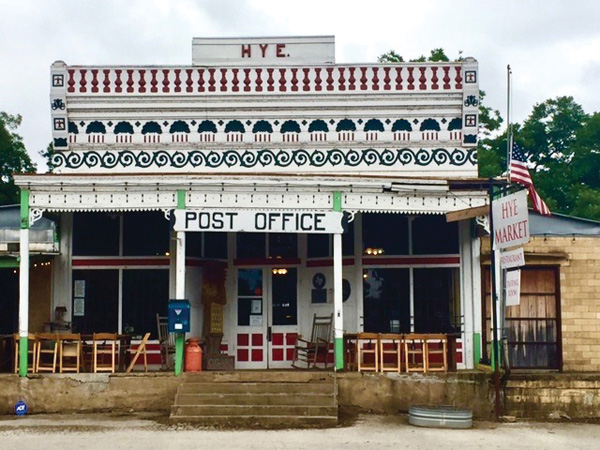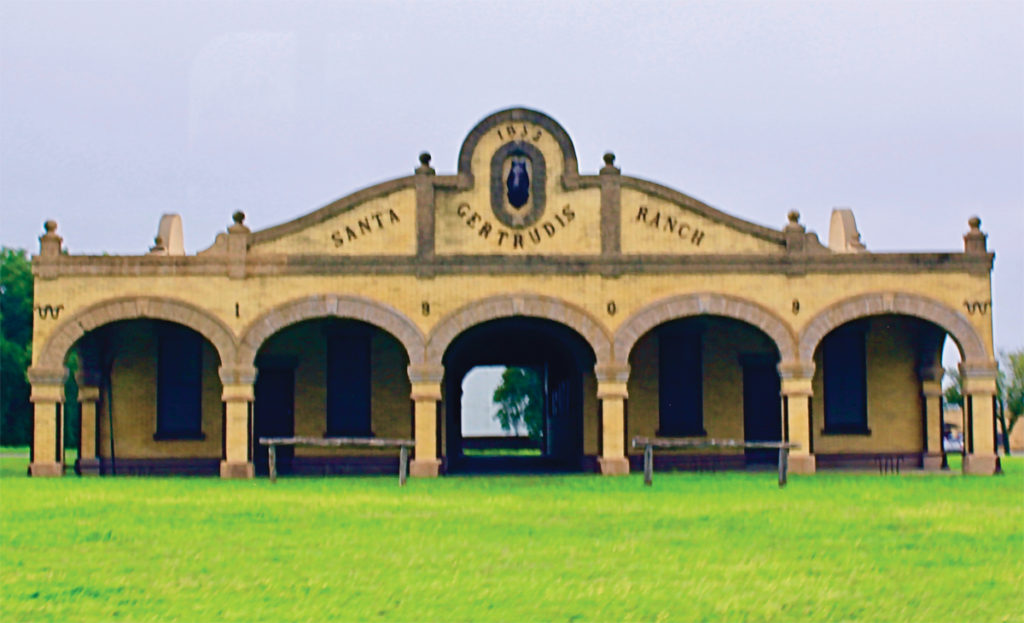
By Michael W. Gos
Hye, Texas
Whenever I’m on my way to Fred, I usually travel along 290, passing Dripping Springs, Johnson City, over a dozen wineries, and the tiny town of Hye, with a population of 96. Like Luckenbach, Hye is a small town that is virtually a ghost town now, except for a few buildings along the highway. Unlike Luckenbach however, it still has a working post office, but I suspect it is unlike any you have ever seen. This mail spot is famous because it is where President Lyndon Johnson posted his first letter, at the age of four. As is the case with Luckenbach, the post office is not a stand-alone building. Here, it is located inside the town’s landmark, the Hye Market.
When you first approach the Hye Market, you notice that the building appears to be in poor shape. In fact, you see signs that it never was in the best of shape to begin with. Built in 1904, the building is slightly out-of-line, and the colors are not quite right—faded perhaps, or just the work of a painter who had no artistic sense. The inside, frankly, is a conglomeration of unrelated work areas that don’t quite fit together. There is a restaurant, a wine tasting area, a meat and cheese market, and the post office, which is open a couple of hours a day–when the postmistress decides to show up. (My wife wants her job!). It is, frankly, a mess—as far from perfect as you can possibly get. And it is absolutely beautiful.
♦
One thing that has often puzzled me is why we humans spend so much time and effort in trying to perfect ourselves. That is not to say that some attention to our appearance, behavior and personalities is not in order. Most of us try to dress well (at least sometimes), some women wear makeup, and we are generally trying to be better at all the things we do in our daily lives. And that is good. But I wonder if some of the other goals we pursue might be a bit more dubious. Think of all the hours–and dollars–we spend in the gym, trying to capture those perfect six-pack abs. Don’t get me wrong. Although I myself have gone the full distance in this area and have acquired the whole keg, I do appreciate others’ attempts to achieve this perfection. But is this goal realistic? More important, is the quest good for our well-being?
While the human body is indeed a marvel, it is far from perfect in design and no amount of attention or effort on our part will change that. For example, we have nasal sinuses that drain upward, genes that don’t work, nerves that take bizarre paths, and an appendix that does nothing but cause trouble. And then there is the human knee. Talk about design flaws! The engineer really blew it on that one.
Given that we are starting out with a flawed body and that none of us will ever reach the state of perfection, why do we still strive? I suppose it is because we know that, while we all have many goals we work toward but will never achieve, the quest itself leaves us at least a bit closer to the goal and we are better for it. And yet, I can’t help but think that, in this area at least, we may have gone overboard. Facelifts, liposuction and injecting rat poison (Botox) into our faces in an effort to achieve that perfect look seems to be a sign that, as a society, we may have gone a bit over the edge (okay, maybe more than a bit). We’ve all seen people who have done the plastic surgery thing so many times that they have reached the “lizard stage” where they can no longer move the muscles in their faces. Perfecting the human body is, indeed, impossible.
If we do find ourselves driven to achieve perfection, a better outlet might be to seek it in more important areas of life, like competence in our work or building character. There, at least, we might expect that an effort toward perfection could have a positive effect on our lives. But this approach has its problems as well.
Research suggests that the pursuit of perfection, in any form, hampers success in many areas of our lives. There are studies that show the quest for perfection is often the road to depression, anxiety, addiction, and a sense of paralysis, the inability to make decisions or take action. All in all, the quest for perfection sounds like a losing proposition.
Alternatively, let’s look at this issue from a different perspective. So far we have concentrated on the negative effects of the pursuit. Instead, let’s examine the positive effects of just accepting the imperfections we encounter in life. I would argue that it is the small imperfections in things that make them beautiful. Think about that old, gnarly grapevine or olive tree. Really, could anything be more beautiful? For centuries, we have used old, misshapen briar wood to create some of the world’s most beautiful smoking pipes. And every drop-dead gorgeous woman I have ever seen has at least one small “flaw” (beauty mark?) to round out the picture. Think about it. Beauty often lies in the imperfections.
But imperfections contribute to more than just beauty. They are proof of authenticity. Like the human body, nothing in nature is perfect. In fact, nothing real can ever be perfect. If someone, or something, looks too good to be true, we know it is. When an artist weaves an expensive oriental rug, he always leaves one knot mis-tied. This act of introducing an imperfection is the guarantee of its authenticity. The same is true for us. The real me is imperfect, warts and all (well, not really—a few battle scars maybe, but no warts). The same holds true for everything else in the universe. And of course, we all know, whether we acknowledge it or not, that unless we can relax and be authentic, be who we really are, we can’t possibly be happy in our relationships, or in our lives. Imperfection is a basic requirement for happiness.
The Hye market is beautiful precisely because of its many imperfections. When you first see the building, and especially when you walk in and make your way through the hodge-podge of rooms, you immediately feel that sense of calm comfort that radiates from every corner. What you are feeling is not just its beauty, but its authenticity. It is a building comfortable in its own skin. If a building can do that, why can’t we?
There is beauty and humility in imperfection. Celebrate your imperfection; it is the essence of who you are.



 By Michael W. Gos
By Michael W. Gos



 By Michael W. Gos
By Michael W. Gos

